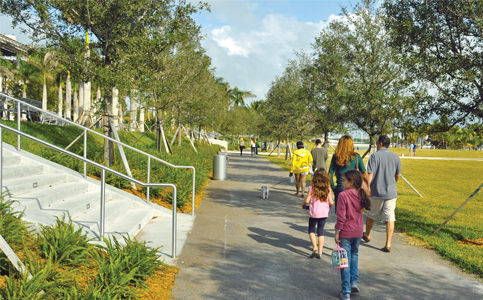Miami parks look ahead a decade to outline aims

Advertisement

Upgrades are coming to Miami’s parks as the city has updated its master plan, which aims to create an accessible, sustainable and vibrant outdoor environment that promotes recreation and the community’s well-being.
At its last meeting before the summer recess, the Miami City Commission adopted a new master plan to improve and grow its park system over the next decade. The four-phase project encompasses all aspects from the land itself, amenities and buildings to programs, funding, staffing and administration.
Tying it all together is a vision is to provide parks, public recreational spaces, educational and cultural programs that are responsive, resilient and inspiring.
Given the development Miami has seen over the years, lessons of the Covid-19 pandemic and the projection for continued growth, the city believes it’s opportune to establish a new long-range plan for its parks and recreation system which hasn’t been updated since 2007.
Under the new approach, the city will assess existing conditions and identify parks and recreation trends, needs and priorities. The information gathered will be used to provide strategic and resilient recommendations for improvements and provisions of facilities, programs, services, land acquisition and development.
The first phase of context analysis will build on previous plans and consider what the city’s population will look like in 10 years as it is anticipated to grow by over 25,000. Population density is expected to range from 20 people per acre to 225 in downtown. This means Miami will need more parks and land will continue to be at a premium, requiring creative and aggressive means of expansion.
The second phase focuses on a needs assessment that will use level of service analysis, other quantitative measures and community input to determine the gaps between existing and desired conditions. High-priority city-wide facilities include its natural areas, park restrooms, sidewalks and trails, outdoor pools and dog parks.
Building off the context analysis and needs assessment, the third phase is to establish the framework for revamping the parks system over the next decade and beyond.
Its guiding principles are to renew existing facilities and programs to provide high-quality experiences, connect the parks seamlessly into the community to be accessible and inclusive, and expand the system to catch up with Miami’s growth.
The city will work to upgrade facilities and amenities, expedite capital improvement projects, plan and integrate public art into parks. Initiatives are to amplify awareness of programs and services and expand partnerships.
Physical connections to the community are also to be enhanced with improved pedestrian and bicycle paths, and multi-modal transit access is to be provided to parks.
Level of service targets include three acres of parkland per 1,000 residents, a park within a 5-minute walk of downtown and a 10-minute walk in the rest of the city, and an indoor recreation center within one mile of every resident.
The final phase consists of the enacting strategy, which provides a detailed look at how the vision can be achieved, funding opportunities as well as how projects and policies should be prioritized.
Funding sources include Miami Forever Bonds, grants and partnerships. The plan lists allocation targets, with 39% of funds used to develop new parks and recreational spaces, 36% to upgrade existing facilities, 14% to improve walking and bike trails and 11% to acquire parkland.
The master plan is also to see that all parks meet the requirements for the Commission of Accreditation of Parks and Recreation Agencies. It is the only national accreditation for parks and recreation agencies and is a measure of the overall quality of operation, management and service to the community.


